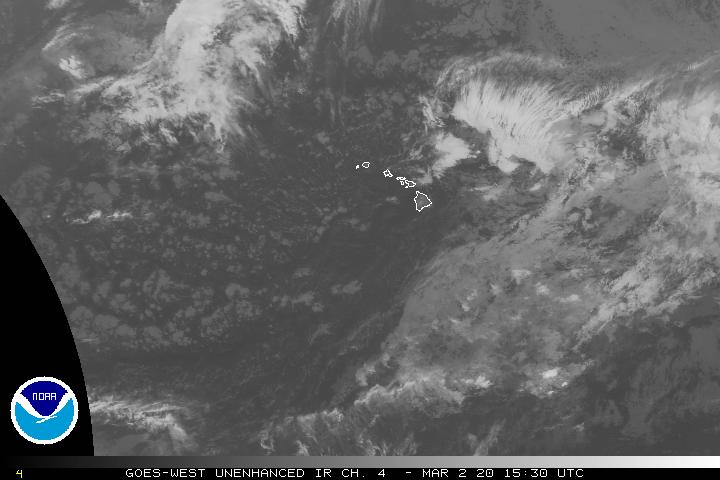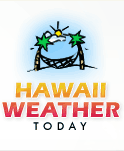Air Temperatures – The following high temperatures (F) were recorded across the state of Hawaii Tuesday…along with the low temperatures Tuesday:
79 – 65 Lihue, Kauai
84 – 69 Honolulu, Oahu
mm mm Molokai
83 – 59 Kahului AP, Maui
81 – 68 Kailua Kona
80 – 66 Hilo AP, Hawaii
Here are the latest 24-hour precipitation totals (inches) for each of the islands Tuesday evening:
0.09 Anahola, Kauai
0.25 Punaluu Pump, Oahu
0.05 Molokai
0.01 Lanai
0.00 Kahoolawe
0.01 West Wailuaiki, Maui
0.57 South Point, Big Island
The following numbers represent the strongest wind gusts (mph) Tuesday evening:
08 Moloaa Dairy, Kauai
15 Kii, Oahu
22 Molokai
08 Lanai
33 Kahoolawe
13 Hana, Maui
29 South Point, Big Island
Hawaii’s Mountains – Here’s a link to the live webcam on the summit of our tallest mountain Mauna Kea (nearly 13,800 feet high) on the Big Island of Hawaii. Here’s the webcam for the Haleakala Crater on Maui. These webcams are available during the daylight hours here in the islands, and at night whenever there’s a big moon shining down. Also, at night you will be able to see the stars — and the sunrise and sunset too — depending upon weather conditions.
Aloha Paragraphs

High pressure northeast…gale lows with a pair of cold fronts northwest

High cirrus and a cold front near Kauai

Clear to partly cloudy…some cloudy areas

Showers locally…some heavy near Kauai – Looping image
~~~ Hawaii Weather Narrative ~~~
Small Craft Advisory…Kauai northwest waters, Kauai windward and leeward waters, Kauai Channel, Oahu windward, Kaiwi Channel
High Surf Advisory…north and west shores of Niihau, Kauai, Oahu, Molokai and north shore of Maui
Broad Brush Overview: There are two cold fronts approaching Kauai from the northwest, which are causing our local winds to weaken. This will allow sea breezes to develop over the western islands, with clouds and a few showers over some interior areas. As the fronts merge, and reach Kauai early Wednesday, it will weaken to a surface trough, producing clouds and showers across some of the smaller islands. An upper level trough passing over the state Wednesday into Thursday may also enhance rainfall, particularly over the Big Island. A weak ridge moving over the islands later this week…will cause light and variable winds Friday through the weekend.
Details: The surface ridge north of the state will continue to weaken and push south toward the islands…while the high northeast of the Big Island will move east. Our winds will remain east to east-southeast near the Big Island, while they shift southeast and weaken over the smaller islands. This will allow local sea breeze circulations to develop across some of the islands, as well as bring localized volcanic haze (vog). Clouds and isolated showers are also possible over the interior sections of some of the smaller islands…especially on Kauai and Oahu.
This enhanced moisture, combined with the unstable conditions due to the upper level trough moving across the area, may increase rainfall more significantly over portions of the Big Island. The best chance for these potentially heavier downpours, and possible thunderstorms developing on the Big Island…would be Thursday afternoon. However, for now there’s no mention of heavy rain and thunderstorms in the Big Island forecast. It’s still not a sure thing, although things could go in this direction, stay tuned.
Looking Further Ahead: Once the upper level trough moves east of the Big Island late Thursday, the possibility of enhanced precipitation will diminish. A weak surface ridge will move over the islands from the west Friday, and remain in place through the weekend. This ridge will produce light and variable winds with a stable weather pattern. Look for daytime sea breezes with afternoon clouds and a slight chance of showers across interior sections, followed by local nighttime land breezes with clearing skies each night through the weekend. It looks like light trades may return to the state early next week…returning the focus for showers to the windward sides.
Here’s a wind profile of the Pacific Ocean – Closer view of the islands / Here’s the vog forecast animation / Here’s the latest weather map
Marine environment details: A large northwest swell will arrive and persist for several days. Advisory level surf is expected along most north and west facing shores of the smaller islands Wednesday, and may approach warning levels with the expected peak Thursday. An even larger northwest swell is due to arrive this weekend.
A further decrease in wind speeds is expected as a cold front approaches the area from the northwest. As the front stalls and weakens near Kauai and Oahu Wednesday and Wednesday night, a new high building northwest of the area will bring a temporary increase in trade winds. Although winds will likely be below SCA criteria for much of the week, the northwest swells will lead to combined seas exceeding the SCA criteria in many zones beginning Wednesday.
World-wide Tropical Cyclone activity
>>> Here’s the Tuesday PDC Weather Wall Presentation, covering Tropical Cyclone 05S and Tropical Cyclone 04S (Irving) both in the South Indian Ocean
![]()
>>> Atlantic Ocean:
>>> Caribbean Sea:
>>> Gulf of Mexico:
Here’s a satellite image of the Caribbean Sea…and the Gulf of Mexico
Here’s the link to the National Hurricane Center (NHC)
>>> Eastern Pacific:
Here’s a wide satellite image that covers the entire area between Mexico, out through the central Pacific…to the International Dateline.
Here’s the link to the National Hurricane Center (NHC)
>>> Central Pacific:
Here’s a link to the Central Pacific Hurricane Center (CPHC)
>>> Northwest Pacific Ocean: No active tropical cyclones
>>> North and South Indian Oceans / Arabian Sea:
Tropical Cyclone 04S (Irving)
JTWC textual forecast warning
JTWC graphical track map
NOAA satellite image
Tropical Cyclone 05S
JTWC textual forecast warning
JTWC graphical track map
NOAA satellite image
Here’s a link to the Joint Typhoon Warning Center (JTWC)
Interesting: How Much Water Do You Really Need To Drink? – You are what you eat…but if you want to get literal about it, you are mostly what you drink. So, how much of that should be water?
About 60 percent of the average adult human body is made of water, according to a National Institutes of Health report. This includes most of your brain, heart, lungs, muscles and skin, and even about 30 percent of your bones. Besides being one of the main ingredients in the recipe for humankind, water helps us regulate our internal temperature, transports nutrients throughout our bodies, flushes waste, forms saliva, lubricates joints and even serves as a protective shock absorber for vital organs and growing fetuses.
There’s no dispute that water is crucial to a healthy life (or any life at all, for that matter). And yet, there’s little scientific consensus about the exact amount of the stuff an individual should consume each day. So how much water do you actually need to drink to be healthy?
You may have heard that you should drink eight 8-ounce glasses of water a day. That’s the wrong answer. Despite the pervasiveness of this easily remembered rule, there is no scientific evidence to back it up, according to a 2002 review of studies. In fact, numerous studies suggest that this is far more actual drinking water than is necessary for most healthy adults.
The problem with this rule, researchers say, is that drinking water by the glass is not the only way that humans hydrate. Yes, it’s true that guzzling H2O is an inexpensive and calorie-free way to whet your whistle, but the “8 x 8” rule crucially overlooks two big sources of daily water consumption.
Food and drink
One such source is food. Everything you eat contains some water. Raw fruits and vegetables have a lot; fruits such as watermelons and strawberries, for example, are more than 90 percent water by weight, according to the U.S. Department of Agriculture. Different diets naturally contain different amounts of water, but it adds up. According to a 2004 report by the National Academies of Sciences, the average North American gets about 20 percent of his or her daily water intake through food, and that counts toward healthy hydration.
The other key water sources that the “8 x 8” rule overlooks are other beverages. Non-alcoholic drinks such as coffee, tea, milk, juice and soda contain mostly water, and all contribute to your hydration. Contrary to another popular myth, studies show that coffee does not dehydrate you and is a suitable form of H2O intake. (Just remember that there can be adverse side effects of drinking too much caffeine, including headaches and disrupted sleep.)
So, between all the food, water, and other fluids you consume in a day, how much water should you aim to imbibe? The National Academies of Sciences suggests that women consume a total of approximately 2.7 liters (91 ounces) of water from all beverages and foods each day and that men get approximately 3.7 liters (125 ounces) daily. But these are just general guidelines and are not supported by firm scientific studies.
The truth is, there is no magic formula for hydration — everyone’s needs vary depending on their age, weight, level of physical activity, general health and even the climate they live in. The more water you lose to sweating, the more water you’ll need to replace with food and drink. So, naturally, a person doing strenuous physical work in a hot, tropical climate would need to drink more water than a person of identical weight and height who spent the day sitting in an air-conditioned office.
If you are looking for concrete advice, though, the best place to look is within.
“The vast majority of healthy people adequately meet their daily hydration needs by letting thirst be their guide,” according to the National Academies of Sciences. Your body naturally feels thirsty when your hydration levels are dropping, and water is the best medicine. (On the other end of the digestive spectrum, your urine can also tell you whether you’re getting enough to drink — dark yellow or orange urine usually indicates dehydration, while well-hydrated urine should look pale yellow or colorless.)
The bottom line: Drink up when you’re thirsty, and drink more when you sweat more. Your body will take it from there.













 Email Glenn James:
Email Glenn James:
Marie Rengstorff Says:
The latest 1/09/18 SCIENCE NEWS reports on the warm seas and sea turtles. The warm seas are causing an increase in females turtles, probably due to the same factors that control number of each sex in alligators and lizards. Over-generalizing the principal, in bad environmental situations, having more females helps preserve the species.
~~~ Hi Marie, good to hear from you, and thanks for the tip on the interesting article. It sounds like causing rain or putting up tents along the beaches are a couple of possible ways to cool the area…and potentially prompting more needed males.
Aloha, Glenn